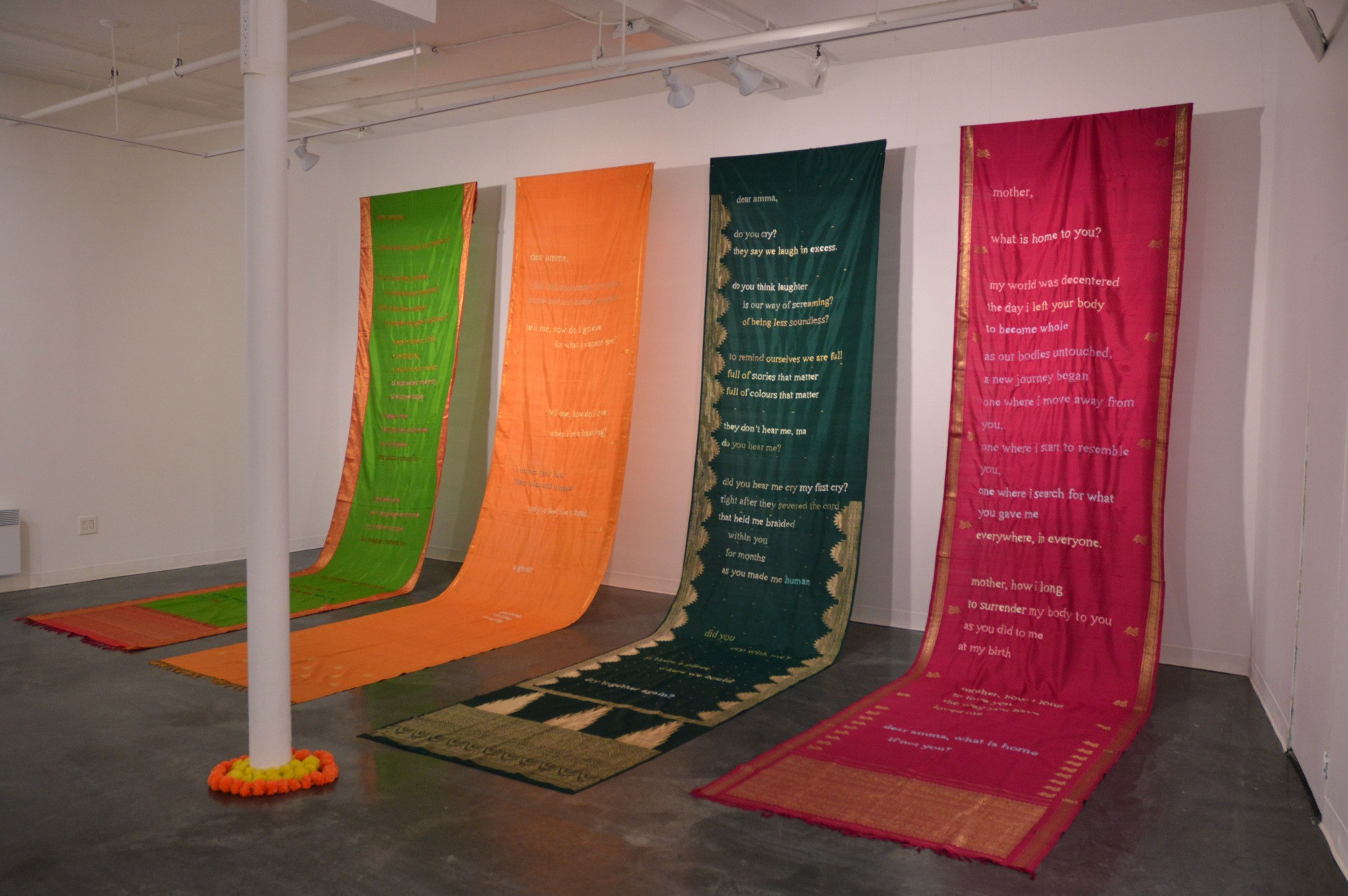We were lucky to catch up with Par Nair recently and have shared our conversation below.
Par, thanks for taking the time to share your stories with us today Can you talk to us about a project that’s meant a lot to you?
One of the projects that holds a lot of meaning to me is a textile installation that I created with a series of eight silk sarees, titled “Letters of Haunting” between 2022 and ‘23. The concept for this series started over the pandemic when my mother, who lives in India mailed me one of her silk sarees as a gift. Sarees are typically passed down generations and holds a lot of ancestral memory. So when I opened this mail from my mother who I was longing to see I was deeply touched by her gesture and decided I wanted to do something meaningful with the saree. This is when I decide to hand embroider a poem on the saree. This work is titled, “a touching”, and becomes my first hand embroidered saree work. The exchange that this work facilitates between my mother and I remind me of the act of writing and exchanging letters, and triggers the idea for “Letters of Haunting”. I decide I want to start this body of work that takes me around two years to complete, where I hand embroider letters to my mom, on silk sarees that belonged to her.
The work considers themes of migration, mothering, matrilineal memory, cultural loss, grief, and love. The hand embroidered text on the sarees are love letters addressed to “amma”, meaning mother in my mother tongue Malayalam. “Letters of Haunting” centers the intricate textile practices and ancestral techniques, encouraging a deeper understanding and knowledge of South Indian textiles and hand embroidery techniques. It highlights textiles as holders of memory, threading diasporic narratives across borders and generations. The series has since been displayed both nationally and internationally.
One of the letters read,
dear amma,
what is home to you?
my world was decentered
the day i left your body
to become whole
as our bodies untouched,
a new journey began
one where i move away from you,
one where i start to resemble you,
one where i search for what you gave me
everywhere, in everyone.
mother, how i long
to surrender my body to you
as you did to me
at my birth
mother, how i long
to love you
the way you have
loved me
dear amma, what is home
if not you?


Great, appreciate you sharing that with us. Before we ask you to share more of your insights, can you take a moment to introduce yourself and how you got to where you are today to our readers.
I was born in Kerala, South India and moved to Canada in my early twenties and have been here for the past fourteen years. Because I’ve found myself navigating between two homes for many years now, a lot of the work I make addresses the diasporic journeys of South Asian community highlighting voices and stories of peoples historically silenced in colonial spaces. I often find myself returning to ancestral practices and using familial archives are starting points for my creative practice.
I’m trained in oil painting and have been painting for over ten years, but over the course of the last few years my practice has taken on an interdisciplinary voice and I’ve started to explore hand embroidery, textile installations and creative writing. My textile practice has allowed me to consider the unique ways in which textiles can touch, hold memories and tell stories the way other mediums cannot.
I prioritize sustainability by reusing and incorporating clothing passed down to me from my mother, my grandmother and other women in my family to explore the significance of textiles in the context of migration and unravel the intricate tapestry of South Asian diaspora through the lens of Indian textiles.
When I’m not in my studio making, I’m teaching at OCAD University!


Is there a particular goal or mission driving your creative journey?
I’ve always thought of my work as a way to challenge dominant narratives to foster a deeper understanding of South Asian diaspora. My aim is to to highlight the role, history and invisible labour attached to women’s work as embroiderers and mothers, and how hand embroidery may heal ancestral wounds. My creative research calls attention to canonically underrepresented art practices for community building, and sustainability. It disrupts and questions the white cube rhetoric through textiles, decorative arts and handmade artistic methods. My intention is to break ground and highlight stories that have been traditionally sidelined by institutional frameworks. My work asks, “how does my embodied inventory and body archive, re-orient and re-position itself with regard to colonial histories?” “How can our stories find belonging and healing ?”
Through an interdisciplinary and cross- historical lens, my practice-based research prioritizes care and community building. It allows me to gain a broader perspective of craft traditions and storytelling of my ancestors; and is a way for me to collaborate with the women who came before me while unravelling the cultural, historical and personal narratives embedded in South Indian textiles and hand embroidery.


What do you find most rewarding about being a creative?
One of the most rewarding aspects of being an artist is to have complete strangers connect with your work in ways you never thought possible. I’ve discovered how art holds the potential to transcend barriers and it is… magic!
Contact Info:
- Website: www.parnair.format.com
- Instagram: @parnairr
- Facebook: Par Nair Nielsen





Image Credits
Image 1: Photo by Brody Nielsen
Image 2: Photo by Toni Hafkenschied
Image 3: Photo by Brody Nielsen
Image 4: Photo by Jocelyn Reynolds/Craft Ontario
Image 5 & 6: Photo Credit of the artist
Image 7: Photo by Laura Sbrizzi
Image 8: Photo by Brody Nielsen
Image 9: Photo by Jocelyn Reynolds/Craft Ontario
Image 10 &11: Photo Credit of the artist


